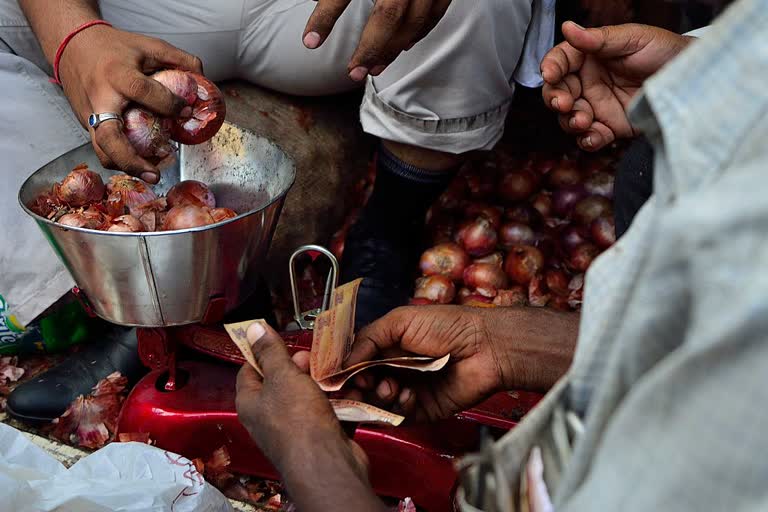Business Desk, ETV Bharat: Onion prices have shot up again across the country in the past few days due to sudden rains in major producing states like Maharashtra and Andhra Pradesh.
Maharashtra accounts for the highest production of onion in the country, with about 80% of the commodity coming from the state. Unexpected rains have hit the arrival of the new crop there, while the old stock is declining, thereby pushing up prices.
Onion prices at Maharashtra’s Lasalgaon Market Committee, which is one of the largest onion market committee in the country, are hovering at around Rs 7,000 per quintal, the highest so far this year.
Normally about 14,000-15,000 quintals of onion arrive in this market daily. However, only 3,500 to 4,000 quintals of summer onions have arrived at the market in the last eight days.
Consequently, retail prices have spiked to Rs 66 per kg in Nashik on Tuesday compared with Rs 35 per kg in the year-ago period.
In Andhra Pradesh, too, the retail cost of onion has shot up to Rs 75-80 per kg after the recent floods.
In other major cities, prices stood at Rs 90 per kg in Hyderabad, Rs 130 per kg in Chennai's Koyambedu market.
In what may worsen the price situation, onion is also not an essential commodity anymore after the Essential Commodities (Amendment) Bill 2020 passed last month removed it from the list.
This means farmers and marketers are now free to produce and hold the commodity as per the market dynamics and the central government cannot regulate its supply by imposing stock limits on the quantity that individuals/wholesale traders can stockpile.
Read more: Videocon insolvency case: Dhoot family offers to pay Rs 30,000 cr to lenders
This may raise the risks of hoarding onions by traders, which could result in artificial price rise.
“The government has been ill-advised in taking onions out of the Essential Commodities Act. On one hand, the Centre is saying it wants to liberalize the regulatory environment, while on the other hand it has imposed a ban on exports. These steps seem contradictory and have clearly not served the purpose,” said agriculture expert Indra Shekhar Singh, Director- Policy and Outreach, National Seed Association of India.
To recall, the government had banned onion exports in September 2019 as well after a bad crop crimped output.
Still, in December that year, prices soared to Rs 80 per kg in the national capital.
The government then lifted the ban on 15 March 2020 after prices came under control before re-imposing onion export ban this September.
“The rising of onion prices is not a new thing. It has been happening at least for the last 24 years. The situation is even worse now since onion farmers today get less than what they got in 1996 for their crop if one adjusts inflation. This indicates that there are middlemen that manipulate the supply chain dynamics every year and benefit from the price hike,” he added.
Singh highlighted the example of the Dal scam 2015 where investigations by the Income Tax department revealed that the abnormal price situation in India was created by a coordinated collusive activity orchestrated by few trading and financial entities.
Speaking on the same issue, finance minister Nirmala Sitharaman earlier this month in a press conference said that the government is focussing on opening up the system so that the buyer and farmers can access each other directly and get best prices.
“Every year, during the crop yield season, the price of onion fluctuates. It will increase during yield and will gradually decrease afterwards. This is the problem with perishables like onion,” said Sitharaman in reply to a question asked by Etv Bharat.
“When prices went up to Rs 200, farmers got the same Rs 5. We as consumers didn't care about farmers. But the government has to think how much money out of that Rs 200 can go to farmers,” she said, adding: “If farmers sell directly there will be no problem. They will get remunerative prices for their produce.”
Experts are hopeful that the latest relaxation of import norms till Dec 15 will calm down the retail price of the key kitchen staple.



